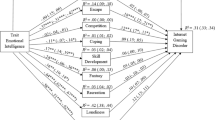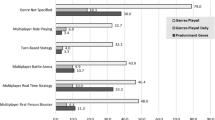Abstract
Pathological gaming is the recurrent, persistent, and excessive involvement of an individual with online or offline video games. According to the Interaction of Person-Affect-Cognition-Execution Model of Brand, Young, Laier, Wolfling, and Potenza, pathological gaming is a consequence of interactions between the person’s core characteristics, coping styles, and conditioning processes, which leads to behavioral addictions. Studies have shown that personality traits strongly influence video gaming behaviors. In this study, 1026 Filipino gamers completed the NEO-Five-Factor Inventory-3 and the Internet Gaming Disorder Scale. The results with the Five-Factor Model Traits showed Neuroticism to be positively correlated with pathological gaming, while Extraversion, Openness, Agreeableness and Conscientiousness were negatively correlated with pathological gaming. Forward stepwise regression also indicated that Agreeableness and Conscientiousness were negative predictors, with Conscientiousness being the strongest predictor among the five factors. The findings of the study can help raise awareness about pathological gaming, and the importance of its prevention and possible rehabilitation, among Filipino gamers.
Similar content being viewed by others
References
American Psychiatric Association. (2000). Diagnostic and statistical manual of mental disorders (DSM) (4th ed.). Washington, DC: Author.
American Psychiatric Association. (2013). Diagnostic and statistical manual of mental disorders (DSM) (5th ed.). Arlington, VA: Author.
Andreassen, C. S., Griffiths, M. D., Gjertsen, S. R., Krossbakken, E., Kvam, S., & Pallesen, S. (2013). The relationships between behavioral addictions and the five-factor model of personality. Journal of Behavioral Addictions, 2(2), 90–99.
Blumberg, F. C., Altschuler, E. A., Almonte, D. E., & Mileaf, M. I. (2013). The impact of recreational video game play on children’s and adolescents’ cognition. New Directions for Child and Adolescent Development, 2013(139), 41–50.
Brand, M., Young, K. S., Laier, C., Wölfling, K., & Potenza, M. N. (2016). Integrating psychological and neurobiological considerations regarding the development and maintenance of specific internet-use disorders: An interaction of person-affect-cognition-execution (I-PACE) model. Neuroscience and Biobehavioral Reviews, 71, 252–266. https://doi.org/10.1016/j.neubiorev.2016.08.033.
Braun, B., Stopfer, J. M., Müller, K. W., Beutel, M. E., & Egloff, B. (2016). Personality and video gaming: Comparing regular gamers, non-gamers, and gaming addicts and differentiating between game genres. Computers in Human Behavior, 55, 406–412. https://doi.org/10.1016/j.chb.2015.09.041.
Charlton, J. P. (2002). A factor analytic investigation of computer addiction and engagement. British Journal of Psychology, 93(3), 329–344.
Charlton, J. P., & Danforth, I. D. (2010). Validating the distinction between computer addiction and engagement: Online game playing and personality. Behaviour & Information Technology, 29(6), 601–613.
Cherry, K. (2019). What are the Big 5 personality traits? Retrieved from https://www.verywellmind.com/the-big-five-personality-dimensions-2795422. Accessed 25 May 2019.
Choo, H., Gentile, D. A., Sim, T., Li, D., Khoo, A., & Liau, A. K. (2010). Pathological video-gaming among Singaporean youth. Annals Academy of Medicine, 39(11), 822–829.
Collins, E., Freeman, J., & Chamarro-Premuzic, T. (2012). Personality traits associated with problematic and non-problematic massively multiplayer online role playing game use. Personality and Individual Differences, 52(2), 133–138.
Costa, P. (1994). Revised NEO personality inventory (NEO PI-R) and NEO five-factor inventory (NEO-FFI): Professional manual. Lutz, FL: Psychological Assessment Resources.
Donnellan, M. B., Oswald, F. L., Baird, B. M., & Lucas, R. E. (2006). The Mini-IPIP Scales: Tiny-yet-effective measures of the Big Five Factors of Personality. Psychological Assessment, 18(2), 192–203.
Feist, J., Feist, G. J., & Roberts, T. (2013). Theories of personality (8th ed.). New York, NY: McGraw-Hill Higher Education.
Feng, W., Ramo, D. E., Chan, S. R., & Bourgeois, J. A. (2017). Internet gaming disorder: Trends in prevalence 1998–2016. Addictive Behaviors, 75, 17–24. https://doi.org/10.1016/j.addbeh.2017.06.010.
Gaming disorder. (2018, September 14). Retrieved from https://www.who.int/features/qa/gaming-disorder/en/.
Goldberg, L. R. (1999). A broad-bandwidth, public domain, personality inventory measuring the lower-level facets of several five-factor models. Personality Psychology in Europe, 7, 7–28. Retrieved from https://ipip.ori.org/Abroad-bandwidthinventory.pdf.
Jeong, E., & Lee, H. (2015). Addictive use due to personality: Focused on big five personality traits and game addiction. World Academy of Science, Engineering and Technology International Journal of Psychological and Behavioral Sciences, 9(6), 2032–2036.
John, O. P., & Srivastava, S. (1999). The Big Five Trait taxonomy: History, measurement, and theoretical perspectives. In Handbook of personality: Theory and research (pp. 102–138). New York, NY: Guilford Press.
Johnson, B. (2001). Toward a new classification of nonexperimental quantitative research. Educational Researcher, 30(2), 3–13.
Kim, N. R., Hwang, S. S., Choi, J., Kim, D., Demetrovics, Z., Király, O., et al. (2016). Characteristics and psychiatric symptoms of internet gaming disorder among adults using self-reported DSM-5 criteria. Psychiatry Investigation, 13(1), 58–66.
Király, O., Griffiths, M. D., & Demetrovics, Z. (2015). Internet gaming disorder and the DSM-5: Conceptualization, debates, and controversies. Current Addiction Reports, 2(3), 254–262.
Kuss, D. J., & Griffiths, M. D. (2011). Internet gaming addiction: A systematic review of empirical research. International Journal of Mental Health and Addiction, 10(2), 278–296.
Lehenbauer-Baum, M., Klaps, A., Kovacovsky, Z., Witzmann, K., Zahlbruckner, R., & Stetina, B. U. (2015). Addiction and engagement: An explorative study toward classification criteria for internet gaming disorder. Cyberpsychology, Behavior, and Social Networking, 18(6), 343–349.
Lemmens, J. S., Valkenburg, P. M., & Gentile, D. A. (2015). The internet gaming disorder scale. Psychological Assessment, 27(2), 567–582.
Mark, G., & Ganzach, Y. (2014). Personality and internet usage: A large-scale representative study of young adults. Computers in Human Behavior, 36, 274–281. https://doi.org/10.1016/j.chb.2014.03.060.
Mccrae, R. R., & Costa, J. P. (2007). Brief versions of the NEO-PI-3. Journal of Individual Differences, 28(3), 116–128.
McCrae, R. R., Costa, P. T., Jr., & Martin, T. A. (2005). The NEO-PI-3: A more readable revised NEO personality inventory. Journal of Personality Assessment, 84(3), 261–270.
Mccrae, R. R., & Terracciano, A. (2005). Personality profiles of cultures: Aggregate personality traits. Journal of Personality and Social Psychology, 89(3), 407–425.
Müller, K., Beutel, M., Egloff, B., & Wölfling, K. (2014). Investigating risk factors for internet gaming disorder: A comparison of patients with addictive gaming, pathological gamblers and healthy controls regarding the big five personality traits. European Addiction Research, 20(3), 129–136.
Peters, C. S., & Malesky, L. A. (2008). Problematic usage among highly-engaged players of massively multiplayer online role playing games. Cyber Psychology & Behavior, 11(4), 481–484.
Petry, N. M., Rehbein, F., Gentile, D. A., Lemmens, J. S., Rumpf, H., Mößle, T., et al. (2014). An international consensus for assessing internet gaming disorder using the new DSM-5 approach. Addiction, 109(9), 1399–1406.
Rehbein, F., Kleimann, M., & Mößle, T. (2010). Prevalence and risk factors of video game dependency in adolescence: Results of a German nationwide survey. Cyberpsychology, Behavior, and Social Networking, 13(3), 269–277.
Salguero, R. A., & Morán, R. M. (2002). Measuring problem video game playing in adolescents. Addiction, 97(12), 1601–1606.
Samarein, Z. A., Far, N. S., Yekleh, M., Tahmasebi, S., Yaryar, F., Ramezani, V., et al. (2013). Relationship between personality traits and internet addiction of students at Kharazmi University. International Journal of Psychology and Behavioral Research, 2(1), 10–17.
Schupp, J., & Gerlitz, J.-Y. (2014). Big Five Inventory SOEP (BFI-S). Compilation of social science items and scales. https://doi.org/10.6102/zis54.
Shceck, K., Lee, D. Y., & Pyo, K. B. (2015). The relationship between the five-factor personality model and motivations for play in MMORPGs. Indian Journal of Science and Technology, 8(21), 1–9.
Stockdale, L., & Coyne, S. M. (2018). Video game addiction in emerging adulthood: Cross-sectional evidence of pathology in video game addicts as compared to matched healthy controls. Journal of Affective Disorders, 225, 265–272. https://doi.org/10.1016/j.jad.2017.08.045.
Ventura, M., Shute, V., & Kim, Y. J. (2012). Video gameplay, personality and academic performance. Computers & Education, 58(4), 1260–1266.
Wang, C., Chan, C. L., Mak, K., Ho, S., Wong, P. W., & Ho, R. T. (2014). Prevalence and correlates of video and internet gaming addiction among Hong Kong adolescents: A pilot study. The Scientific World Journal, 2014, 1–9. https://doi.org/10.1155/2014/874648.
Wang, C., Ho, R. T., Chan, C. L., & Tse, S. (2015). Exploring personality characteristics of Chinese adolescents with internet-related addictive behaviors: Trait differences for gaming addiction and social networking addiction. Addictive Behaviors, 42, 32–35. https://doi.org/10.1016/j.addbeh.2014.10.039.
Wittek, C. T., Finserås, T. R., Pallesen, S., Mentzoni, R. A., Hanss, D., Griffiths, M. D., et al. (2015). Prevalence and predictors of video game addiction: A study based on a national representative sample of gamers. International Journal of Mental Health and Addiction, 14(5), 672–686.
Yen, J., Liu, T., Wang, P., Chen, C., Yen, C., & Ko, C. (2017). Association between internet gaming disorder and adult attention deficit and hyperactivity disorder and their correlates: Impulsivity and hostility. Addictive Behaviors, 64, 308–313. https://doi.org/10.1016/j.addbeh.2016.04.024.
Young, K. S. (1998). Caught in the net: How to recognize the signs of Internet addiction–and a winning strategy for recovery. New York, NY: John Wiley & Sons.
Author information
Authors and Affiliations
Corresponding author
Additional information
Publisher's Note
Springer Nature remains neutral with regard to jurisdictional claims in published maps and institutional affiliations.
Rights and permissions
About this article
Cite this article
Reyes, M.E.S., Davis, R.D., Lim, R.A.N.N. et al. Five-Factor Model Traits as Predictors of Pathological Gaming among Selected Filipino Gamers. Psychol Stud 64, 213–220 (2019). https://doi.org/10.1007/s12646-019-00498-y
Received:
Accepted:
Published:
Issue Date:
DOI: https://doi.org/10.1007/s12646-019-00498-y




